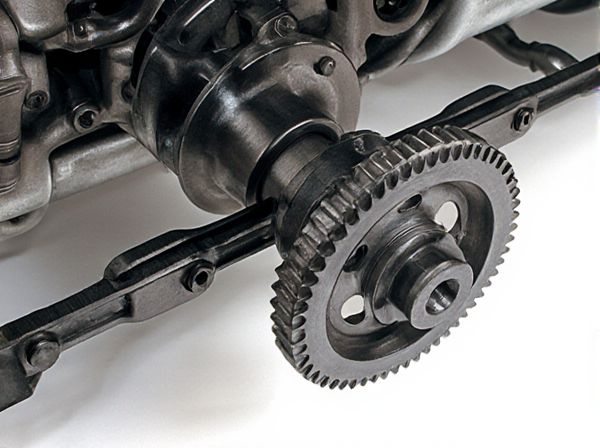
Photo illustration: Flat-Plane Crank vs Cross-Plane Crank
Flat-plane crankshafts offer a lighter, more responsive engine design ideal for high-revving performance, while cross-plane crankshafts provide smoother operation and better torque delivery at lower RPMs. Your choice depends on whether you prioritize sharp throttle response and reduced rotational mass or seek superior engine balance and reduced vibration. Both configurations influence exhaust sound and engine character, affecting the overall driving experience.
Table of Comparison
| Feature | Flat-Plane Crank | Cross-Plane Crank |
|---|---|---|
| Crankshaft Design | 180-degree crank throws, inline firing order | 90-degree crank throws, uneven firing order |
| Engine Vibration | Higher vibration due to secondary imbalances | Smoother operation with better balance |
| Sound Profile | Sharper, higher-pitched exhaust note | Deeper, traditional V8 rumble |
| Power Delivery | Quicker revving, improved high-RPM response | Strong low-end torque, less responsiveness at high RPM |
| Weight | Lighter crankshaft, reduced rotational inertia | Heavier crankshaft, increased rotational inertia |
| Common Applications | High-performance sports cars (e.g., Ferrari V8) | Cruisers and muscle cars (e.g., Ford Mustang GT) |
Introduction to Crankshaft Design
Flat-plane crankshafts feature evenly spaced crank throws aligned on the same plane, resulting in a lighter and more responsive design commonly used in high-revving sports engines. Cross-plane crankshafts have crank throws positioned at 90-degree intervals, providing better primary balance and smoother operation, which is favored in V8 engines for reduced vibration. The choice between flat-plane and cross-plane cranks directly impacts engine sound, balance, and performance characteristics in crankshaft design.
What is a Flat-Plane Crank?
A flat-plane crankshaft features crankpins positioned at 180 degrees, resulting in evenly spaced firing intervals commonly used in high-performance engines like those in sports cars and motorcycles. This design reduces the rotating mass and allows for higher engine revs and improved throttle response, enhancing overall engine performance. Flat-plane cranks generate a distinct exhaust sound due to their firing order and minimize vibration compared to cross-plane crankshafts found in typical V8 engines.
What is a Cross-Plane Crank?
A cross-plane crankshaft features crankpins arranged at 90-degree intervals, creating a unique firing order that enhances engine balance and reduces vibration in V8 engines. This design improves torque delivery and produces a distinctive exhaust sound favored in performance cars like the Ford Mustang GT and Chevrolet Camaro SS. Cross-plane cranks differ from flat-plane cranks primarily in their smoother operation and characteristic auditory profile, despite adding some rotational mass.
Key Differences Between Flat-Plane and Cross-Plane Cranks
Flat-plane cranks feature a 180-degree crankshaft configuration that allows for even firing intervals and reduced rotational mass, resulting in higher RPM potential and a more responsive engine feel. Cross-plane cranks have a 90-degree crankshaft layout, offering smoother power delivery and better torque at lower RPMs due to their inherent vibration dampening and balanced firing order. The key differences lie in the balance between engine smoothness and responsiveness, with flat-plane cranks prioritizing performance and cross-plane cranks emphasizing refinement and drivability.
Performance Characteristics: Flat-Plane vs Cross-Plane
Flat-plane crankshafts offer quicker engine response and higher revving capabilities due to their lighter rotating mass and simpler design, enhancing peak power output in high-performance sports cars. Cross-plane crankshafts provide smoother power delivery and reduced vibration through uneven firing intervals, favoring torque and drivability in muscle cars and V8 engines. The flat-plane design excels in achieving higher RPM limits and aggressive throttle response, while cross-plane crankshafts emphasize low-end torque and refined engine balance.
Sound and Vibration Comparison
Flat-plane crankshafts produce a higher-pitched, more aggressive exhaust note due to their even firing intervals and reduced secondary vibrations. Cross-plane crankshafts generate a deeper, rumbling sound characterized by uneven firing orders, resulting in smoother engine vibrations and better vibration absorption. The flat-plane design offers sharper engine response with increased vibration levels, whereas the cross-plane prioritizes refinement and reduced engine harshness.
Applications: Which Engines Use Which Crank?
Flat-plane crankshafts are commonly used in high-performance sports cars and exotic vehicles such as the Ferrari 458 and Porsche 911 GT3 due to their ability to rev higher and deliver a more responsive throttle feel. Cross-plane crankshafts dominate in American V8 engines like the Ford Mustang GT and Chevrolet Corvette, providing smoother operation and enhanced low-end torque. Motorcycles and racing applications often favor flat-plane designs for their lighter weight and balanced firing intervals, while muscle cars and trucks prefer cross-plane cranks for durability and characteristic engine sound.
Pros and Cons of Flat-Plane Cranks
Flat-plane crankshafts offer higher revving capabilities and a more responsive throttle due to their lighter weight and reduced rotational inertia, making them ideal for performance-oriented sports cars. They produce a distinctive exhaust note and allow for more efficient exhaust gas scavenging, improving horsepower and acceleration. However, flat-plane cranks generate increased vibration and noise, which can lead to reduced engine smoothness and potentially shorter component lifespan compared to cross-plane crankshaft designs.
Pros and Cons of Cross-Plane Cranks
Cross-plane crankshafts offer smoother engine operation and reduced vibration due to their 90-degree crankpin arrangement, improving drivability and rider comfort. The uneven firing intervals provide a distinctive exhaust note and enhanced torque at low to mid RPM ranges, beneficial for street and touring motorcycles. However, cross-plane designs tend to be heavier and more complex, resulting in higher production costs and slightly lower high-RPM performance compared to flat-plane crankshafts.
Choosing the Right Crankshaft for Your Engine
Choosing the right crankshaft for your engine depends on performance goals and engine characteristics; flat-plane cranks offer higher revving capabilities and a more aggressive exhaust note, ideal for sports cars and racing applications. Cross-plane cranks provide smoother power delivery and reduced vibration, making them suitable for muscle cars and street vehicles prioritizing comfort and torque. Understanding these differences helps optimize engine balance, power output, and overall driving experience.
 caratoz.com
caratoz.com